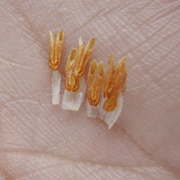James L. Luteyn and Paola Pedraza-Peñalosa
The New York Botanical Garden
|
|
Orthaea is a neotropical genus of ca. 34 species, ranging from Mexico to Bolivia, east to Guyana, and Trinidad. Orthaea was proposed by Klotzsch (1851) in honor of the daughter of Hyacinthus of Greek mythology. It was first described on O. secundiflora (Poepp. & Endlich.) Klotzsch, being characterized by filaments connate and alternately unequal but with anthers of equal length. Hooker (1876) added that the stamens were much shorter than the corolla, but stated that the filaments were distinct not connate. Drude (1891) included it as a subgenus of Thibaudia. Hoerold (1901) re-established Orthaea and mentioned that the filaments of some species were connate while others were distinct. In 1932, A. C. Smith stabilized the concept of Orthaea and recognized 11 species. Furthermore, he described a new genus, Lysiclesia, with two species, noting that its stamens and corollas were exactly like those of Orthaea. |
Lysiclesia differed from Orthaea,
and was characterized, by the enlargements of its calyx limb into three,
bract-like membranaceous lobes instead of the usual five calyx lobes.
In 1934, Sleumer described the monotypic Empedoclesia from Guatemala.
It too had stamens exactly like Orthaea, although the tubules were
proportionally shorter. Sleumer made no mention of relationships
to Orthaea. Empedoclesia was characterized by pedicels
with two large, persistent, bracteoles immediately beneath the calyx.
Within the Ericaceae the character of pedicels with apical bracteoles has
been successfully used at the generic level in Disterigma (ca. 25-30
spp.) and Tepuia (8 spp), where it is consistent in all the species,
and where there are other supportive characters. However, apical
bracteoles may be found in various species of several other neotropical
genera such as Gaultheria, Cavendishia, Mycerinus, Satyria, Thibaudia, Themistoclesia, and Orthaea s.s., and by itself should not be used to define a genus. With no
other supportive morphological characters, recognition of Empedoclesia is unwarranted.
The character of the three large, bract-like calyx
lobes of Lysiclesia is a striking feature that immediately allows
one to recognize the taxa. However, one-character genera are usually
suspect, and are especially so in the neotropical Ericaceae where the reticulate
nature of characters allows one to define genera at best only by a
combination of characters. A reduced number of calyx lobes (from
the basic five) occurs sporadically within other genera of Ericaceae, and
very long or large calyx lobes are not uncommon. Although this feature
is unique in Lysiclesia, I do not feel that it should be used at
the generic level without other supportive characters. Generic guidelines
within neotropical Ericaceae are better sought in (the traditionally accepted)
staminal features. Therefore, Lysiclesia was reduced to subgeneric
status within Orthaea.
Thus, the genus Orthaea is characterized
by stamens 1/3 to 1/2 as long as the corolla, filaments of alternately
unequal lengths, and anthers of equal length dehiscing by terminal pores
or short lateral clefts. It is closely related to Cavendishia,
especially Cavendishia subgen. Chlamydantha, and the supposed
differences between these genera need further study (see Luteyn 1976 and
1983 for a detailed discussion of relationships). Since Orthaea is poorly known and collections are few it is best to maintain it as distinct
from Cavendishia at this time.
ORTHAEA Klotzsch, Linnaea 24: 23. 1851;
Luteyn, Nord. J. Bot. 7: 31-37; Luteyn, Fl. Ecuador 54: 110-120.
1996. Type: Orthaea secundiflora (Poeppig & Endlicher)
Klotzsch.
Lysiclesia A. C. Smith, Contr. U.S. Natl. Herb. 28: 517. 1932. Type: Lysiclesia caudata A. C. Smith.Empedoclesia Sleumer, Notizbl. Bot. Gard. Berlin-Dahlem 12: 124. 1934. Type: Empedoclesia brachysiphon Sleumer.
Low shrubs, frequently epiphytic. Leaves
alternate, evergreen; short- petiolate; blade coriaceous to subcoriaceous,
the venation pinnate or plinerved. Inflorescence axillary, racemose, subfasciculate,
or 1-2-flowered; floral bracts minute to sometimes large and showy, but
usually caducous. Flowers 5-merous, lacking odor; aestivation valvate;
pedicels bibracteolate usually near the base; calyx articulate with pedicel;
hypanthium subcylindric or campanulate, terete or 3-winged, sometimes basally
apophysate; limb erect to suberect, usually 5-lobed; lobes
triangular, rarely 3 and then greatly enlarged, sometimes marginally glandular;
corolla tubular to subcylindric, carnose when fresh but membranaceous when
dry; stamens (8-)10, alternately unequal, usually about 1/3 the length
of the corolla, lacking spurs; filaments distinct or slightly coherent
at the base, alternately unequal; anthers equal or alternately slightly
unequal, basifixed, usually lacking disintegration tissue, but rarely present
(Guayana Highland species); thecae smooth; tubules about the
same width as the thecae but shorter, dehiscing by terminal or slightly
oblique pores; pollen without viscin threads; ovary inferior; style
filiform, about as long as corolla; stigma truncate. Fruit
a berry.
Key to Neotropical Species Back to Top
A key is not currently available.
This web version has been modified from Luteyn 1987a and1996b, but a treatment is still lacking.
